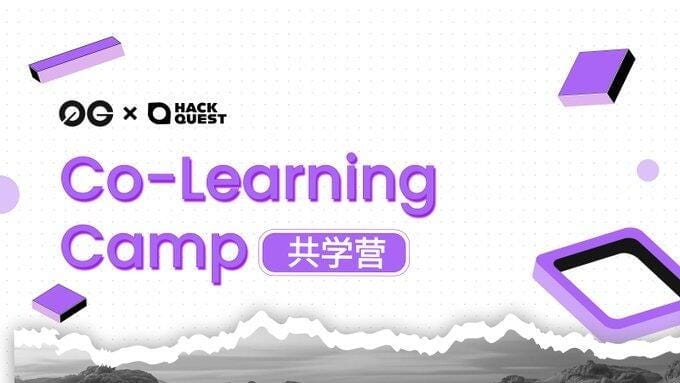The deep cooperation between 0G and HackQuest has recently sparked considerable attention in the developer community. As a developer education platform that has just completed a $4.1 million funding round, HackQuest is becoming an important participant in the educational infrastructure of the Web3 field. Meanwhile, 0G, as the first decentralized AI modular public chain to achieve in-depth cooperation with it, is clearly laying out something of greater structural significance — building a truly future-oriented, open AI developer ecosystem.

From a certain perspective, AI is becoming the most strategically significant resource of this era, but it is still highly concentrated in the hands of a few tech giants. This centralized model brings about many real-world problems: user data is misused, algorithmic decisions are opaque, and profit distribution mechanisms are not public. AI should be a form of inclusive social resource, yet under the current structure, it resembles a 'private territory' of large corporations. This precisely explains why 'decentralized AI' is evolving from a technical concept into an ethical appeal.
Decentralized AI is precisely attempting to respond to these fundamental doubts. It emphasizes openness and co-governance: anyone can participate in the training and reasoning process of AI, algorithms are auditable, and behaviors are traceable, truly allowing 'AI to no longer be a black box'. More importantly, the distributed architecture enhances the system's anti-fragility, eliminating the risk of a complete service collapse due to a single point of failure. In certain high-sensitivity or high-value scenarios — for example, healthcare, finance, public governance — users can even verify and trace the reasoning process of AI. This verifiability is precisely what centralized systems struggle to provide.
From a technical architecture perspective, 0G's choice to enter this track via a modular path is quite worth deliberating. Currently, the vast majority of AI systems are still built on closed, highly coupled architectures, with limited scalability and opaque data flow. In contrast, 0G implements a modular approach from the first layer, including independently upgradable execution, consensus, and storage layers, while being compatible with existing EVM ecosystem applications. Its storage layer, 0G Storage, uses erasure coding and Proof of Random Access (PoRA) mechanisms to ensure data security and availability; the Data Availability (DA) layer achieves consensus by randomly selecting nodes through VRF, seeking a balance between scalability and credibility.
Furthermore, the 0G Serving architecture offers a complete service call SDK, supporting the inference and training processes of AI models, and can integrate automated payment mechanisms. The introduction of decentralized Alignment Nodes aims to truly hand over governance rights to the community while ensuring system efficiency. This entire design conceptually transcends the simplistic imagination of 'on-chain AI' and reimagines a complete, collaborative, and verifiable AI infrastructure.
Of course, modularity is not without its challenges. The inherent latency and coordination complexity of distributed systems still exist, and interoperability between different modules may lead to ecological fragmentation if there is a lack of unified standards. These are all urgent technical issues that need to be addressed.
Although 0G has not yet conducted a TGE, its progress in financing and ecological construction has already attracted significant attention. In January of this year, the project disclosed that it has secured $325 million in funding, which will primarily be used for product expansion and developer community building. From the testnet data, the on-chain transaction volume has exceeded 650 million, the number of accounts has surpassed 22 million, the number of validator nodes has reached 8,000, and the peak TPS of sharding is close to 11,000 — these figures are quite convincing even among leading public chains.
In addition to underlying infrastructure, 0G is also driving innovation at the application layer, and its proposed concept of iNFT (Intelligent NFT) is particularly noteworthy. The essence of iNFT is to encapsulate AI Agents as ownable, tradable, licenseable, and even royalty-generating NFT units, fundamentally reconstructing the ownership and economic model of AI agents. The ERC-7857 standard it follows supports cryptographic metadata and dynamic update mechanisms, meaning that the agents can continuously evolve and appreciate in value, while ensuring the synchronization of metadata and ownership transfer — buyers no longer receive an 'empty shell NFT', but a truly usable, iterable AI asset.
Looking back, the collaboration between 0G and HackQuest is far more than an ordinary ecological interaction. It resembles a forward-looking architectural experiment: by supporting developers to engage with the paradigm of decentralized AI from the educational stage, 0G is actually cultivating the first batch of 'native builders' for itself and the entire track. This strategy, which lays out from the source, may hold more long-term value than pursuing application quantity in the short term.
Currently, 0G demonstrates a considerable degree of competitiveness across four dimensions: ideology, architecture, funding, and ecology. Its choice to focus on a modular, verifiable, and open collaboration-centered AI path aligns precisely with the next generation of AI systems' pursuit of transparency, credibility, and resistance to censorship. The real challenge may lie in whether it can find the optimal balance between performance experience, standard unification, and compliance adaptation, and ultimately transform this vision into a truly usable global network.


